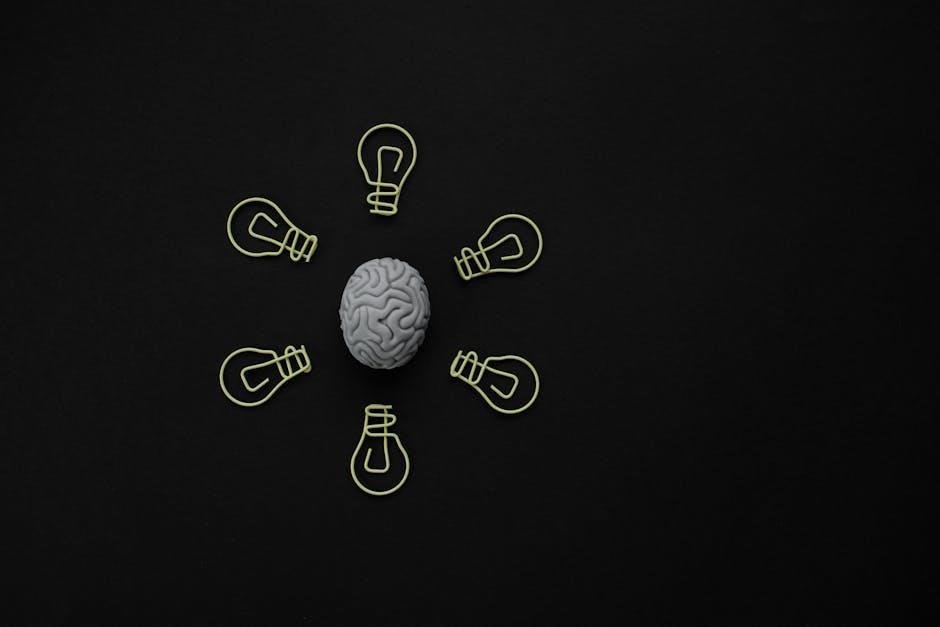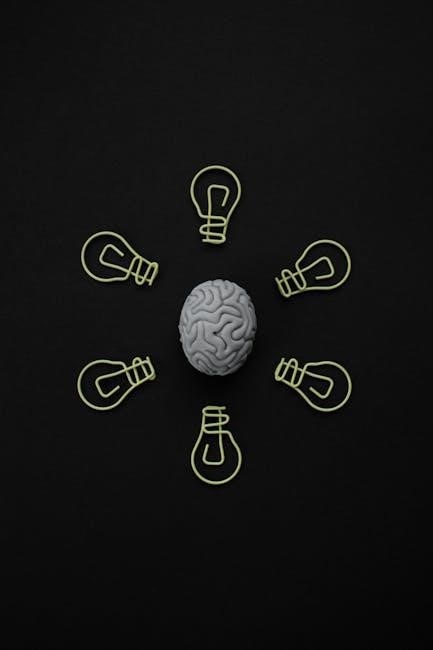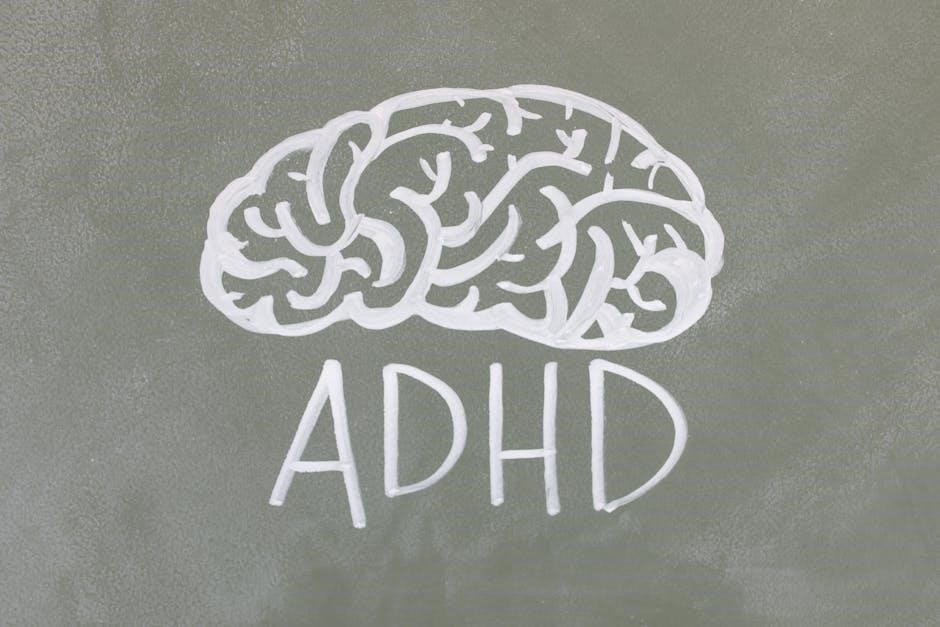Addiction is recognized as a chronic brain disease altering brain structure, function, and neurotransmitter systems, particularly the dopamine pathway, leading to compulsive behaviors and loss of control․
1․1 Understanding Addiction as a Brain Disease
Addiction is now widely recognized as a chronic brain disease characterized by altered brain chemistry, structure, and function․ It affects key brain regions, including the prefrontal cortex, amygdala, and hippocampus, disrupting reward, motivation, and memory systems․ The brain’s dopamine pathways are particularly impacted, leading to compulsive drug-seeking behaviors․ Over time, repeated substance use modifies the brain’s biochemistry, creating long-term changes that perpetuate the cycle of addiction․ This understanding emphasizes that addiction is not merely a moral failing but a complex medical disorder requiring comprehensive treatment approaches․
1․2 The Role of Brain Chemistry in Addiction
Brain chemistry plays a pivotal role in addiction, primarily through neurotransmitters like dopamine and serotonin․ These chemicals regulate pleasure, mood, and reward processing․ Drugs disrupt this balance by flooding the brain with dopamine, creating intense feelings of euphoria․ Over time, the brain adapts by reducing its natural dopamine production, leading to tolerance and dependence․ As addiction progresses, imbalances in serotonin and other neurotransmitters further alter emotional regulation and decision-making․ This chemical restructuring makes it increasingly difficult for individuals to experience pleasure without the substance, deepening the addiction cycle and complicating recovery efforts․

The Brain’s Reward System and Dopamine
The brain’s reward system, driven by dopamine, is central to pleasure and motivation․ Drugs hijack this system, flooding it with dopamine, creating intense euphoria and reinforcing addiction․
2․1 The Mesolimbic Dopamine Pathway
The mesolimbic dopamine pathway, often called the “reward circuit,” plays a crucial role in addiction․ It connects the ventral tegmental area to the nucleus accumbens, regulating pleasure and motivation․ Drugs of abuse, such as cocaine and opioids, flood this pathway with dopamine, creating intense euphoria․ Repeated exposure alters the pathway’s sensitivity, leading to long-term changes in brain chemistry and function․ Over time, the brain becomes dependent on the substance to activate the reward system, driving compulsive drug-seeking behavior․ This pathway is central to understanding how addiction develops and persists, as it directly links drug use to the brain’s reward and motivation processes․
2․2 How Drugs Alter Neurotransmitter Function
Drugs disrupt neurotransmitter function by mimicking or overloading natural chemicals like dopamine, serotonin, and GABA․ This interference alters communication between neurons, leading to heightened pleasure or reduced inhibition․ Chronic use causes the brain to adapt by reducing its ability to produce or respond to neurotransmitters naturally․ For example, dopamine release is exaggerated with drug use, but over time, the brain becomes less responsive, requiring more of the substance to achieve the same effect․ This disruption in neurotransmitter balance contributes to the development of tolerance, dependence, and the compulsive behaviors characteristic of addiction, fundamentally altering brain chemistry and function․
Changes in Brain Structure and Function Due to Addiction
Addiction induces structural and functional brain changes, affecting regions like the prefrontal cortex and hippocampus, leading to impaired cognitive functions, emotional regulation, and decision-making abilities․
3․1 Structural Changes in the Brain
Addiction leads to significant structural changes in the brain, particularly in regions like the prefrontal cortex and hippocampus․ These changes include reduced gray matter volume, altered cortical thickness, and compromised white matter integrity․ The prefrontal cortex, responsible for decision-making and impulse control, often shows atrophy, impairing cognitive functions․ Similarly, the hippocampus, essential for memory formation, may shrink, affecting learning and emotional regulation․ Such structural alterations disrupt normal brain connectivity and neurotransmitter systems, particularly dopamine pathways, contributing to the progression from recreational use to dependence․ These changes are often correlated with the severity of addiction and can persist even after prolonged abstinence, increasing relapse risk․
3․2 Functional Alterations in Brain Activity
Addiction induces profound functional changes in brain activity, particularly in reward, stress, and cognitive control systems․ The mesolimbic dopamine pathway becomes hyperactive, leading to exaggerated responses to drug cues and reduced sensitivity to natural rewards․ Functional MRI studies reveal altered activity in the prefrontal cortex, associated with impaired decision-making and impulse control․ Additionally, the anterior cingulate cortex shows heightened activity, reflecting increased conflict monitoring and compulsivity․ These functional changes disrupt normal neural communication, perpetuating cycles of craving and drug-seeking․ Over time, neuroplasticity reshapes brain circuits, reinforcing maladaptive behaviors and making recovery more challenging․ Such functional alterations underscore the chronic nature of addiction as a brain disorder․
The Stages of Addiction Development
Addiction progresses through stages: initiation, experimentation, regular use, dependence, and relapse, forming a cycle driven by brain changes and compulsive behaviors․
4․1 Initiation and Experimentation
Addiction often begins with voluntary experimentation, driven by curiosity or peer pressure․ Early exposure introduces substances that activate the brain’s reward system, releasing dopamine and creating pleasurable sensations․ This initial stage is characterized by occasional use, as individuals explore the effects without dependency․ However, repeated exposure can alter brain chemistry, fostering a positive association with the substance․ While experimentation may seem harmless, it lays the groundwork for potential addiction by introducing the brain to rewarding stimuli that can gradually lead to compulsive behaviors and dependence over time․
4․2 Transition to Dependence
The transition from experimentation to dependence involves significant biological and psychological changes․ As substance use continues, the brain adapts by altering neurotransmitter systems, particularly dopamine, leading to tolerance․ This requires increased doses to achieve the same effects․ Simultaneously, the brain associates the substance with survival, prioritizing its use over other activities․ Emotional and environmental cues intensify cravings, making it harder to control consumption․ Over time, dependence develops, characterized by compulsive seeking and use despite negative consequences․ This stage marks a shift from voluntary to involuntary behavior, as the brain’s reward and stress systems are increasingly hijacked by the substance․
4․3 Relapse and Chronic Addiction
Relapse in addiction is a common phenomenon driven by the brain’s long-term adaptations to substance use․ Chronic addiction alters the dopamine pathway, making it hypersensitive to triggers like stress or environmental cues․ These triggers can reactivate cravings, even after prolonged abstinence․ The brain’s neuroplasticity allows it to rewire itself, creating pathways that prioritize substance-seeking over other behaviors․ This cycle perpetuates a vicious loop of relapse and reinstatement․ Chronic addiction is marked by persistent changes in brain structure and function, making sustained recovery challenging․ Understanding these mechanisms is crucial for developing effective interventions to address the complex interplay of biology and environment in relapse prevention․

Tolerance and Withdrawal in Addiction
Tolerance occurs as the brain adapts, requiring more substances to achieve the same effect, while withdrawal triggers physiological responses when substance use ceases, driving the addiction cycle․
5․1 Mechanisms of Tolerance Development
Tolerance develops through adaptive changes in the brain’s neurotransmitter systems, particularly dopamine and glutamate․ Repeated substance use reduces receptor sensitivity and alters synaptic plasticity, diminishing the drug’s initial effects․ This forces individuals to consume larger amounts to achieve the same euphoria, perpetuating the cycle of addiction․ Neuroplasticity plays a key role, as the brain reorganizes pathways to compensate for the constant presence of substances, leading to long-term modifications in brain function and behavior․ These changes are central to the progression from casual use to dependence․
5․2 The Role of Withdrawal in Addiction Cycle
Withdrawal plays a critical role in the addiction cycle by creating a cycle of discomfort and relief-seeking behavior․ When drug use ceases, the brain, adapted to constant substance presence, experiences a rebound effect, leading to symptoms like anxiety, nausea, and irritability․ These symptoms reinforce addiction as individuals seek relief by resuming substance use․ Withdrawal strengthens the addiction cycle by linking abstinence with aversive effects, compelling continued drug use to escape discomfort․ This biological response, driven by neurotransmitter imbalances, perpetuates the cycle of dependence and relapse, making cessation more challenging and highlighting withdrawal’s central role in sustaining addiction․

The Role of Neuroplasticity in Addiction
Neuroplasticity supports addiction by reorganizing brain circuits, reinforcing dependency and compulsive behaviors through structural and functional changes driven by chronic substance use․
6․1 Adaptive and Maladaptive Plasticity
Adaptive plasticity involves positive brain changes, enhancing cognitive functions․ However, maladaptive plasticity disrupts neural circuits, fostering addiction by altering reward and stress systems, leading to compulsive drug-seeking behaviors despite negative consequences․ This imbalance reshapes the brain’s structure and function, making recovery challenging․ Research highlights the role of stress in shifting plasticity from adaptive to maladaptive, exacerbating addiction․ Understanding these mechanisms is crucial for developing targeted therapies to restore healthy neural pathways and improve treatment outcomes for individuals struggling with addiction․
6․2 Stress and Neuroplasticity in Addiction
Stress significantly influences neuroplasticity, altering brain circuits involved in reward, motivation, and emotional regulation․ Chronic stress triggers maladaptive changes in the mesolimbic dopamine system, enhancing vulnerability to addiction․ It disrupts the balance between excitatory and inhibitory neurotransmission, impairing prefrontal cortex function and decision-making․ Stress-induced neuroplasticity fosters compulsive drug-seeking behaviors, reinforcing the addiction cycle․ Research shows that stress-related neurochemical adaptations, such as increased corticosteroid levels, exacerbate cravings and relapse․ Understanding the interplay between stress and neuroplasticity provides insights into addiction’s persistence and highlights the need for interventions targeting these pathways to restore healthy neural function and improve recovery outcomes․ This relationship underscores the complexity of addiction as a brain disease․

Treatment and Recovery
Treatment involves medical and behavioral interventions targeting brain chemistry and function to restore cognitive control and reduce cravings, aiding recovery from addiction’s neurological and behavioral impacts․
7․1 Medical Approaches to Addiction Treatment
Medical approaches to addiction treatment focus on managing withdrawal, reducing cravings, and restoring brain chemistry․ Medications like methadone, buprenorphine, and naltrexone are commonly used to treat opioid addiction by targeting neurotransmitter systems․ For alcohol addiction, drugs such as acamprosate and disulfiram help reduce cravings and block rewarding effects․ Antidepressants and mood stabilizers may also be prescribed to address co-occurring mental health disorders․ Advanced therapies, including deep brain stimulation (DBS) and gene therapy, are being explored to modify brain circuits involved in addiction․ These medical interventions aim to alleviate physical and psychological symptoms, promoting long-term recovery and reducing relapse rates․
7․2 Behavioral and Therapeutic Interventions
Behavioral and therapeutic interventions are cornerstone treatments for addiction, focusing on modifying thoughts, emotions, and behaviors․ Cognitive Behavioral Therapy (CBT) helps individuals identify triggers and develop coping strategies․ Contingency Management uses positive reinforcement to encourage abstinence․ Motivational Interviewing (MI) addresses ambivalence toward recovery․ Support groups, such as 12-Step programs, provide community and accountability․ Mindfulness-Based Stress Reduction (MBSR) teaches mindfulness to manage cravings․ Family therapies, like Multidimensional Family Therapy, repair relationships and improve communication․ These interventions aim to restore brain function, reduce relapse risk, and promote long-term recovery by addressing psychological and environmental factors driving addiction․ They complement medical treatments, offering a holistic approach to healing․
